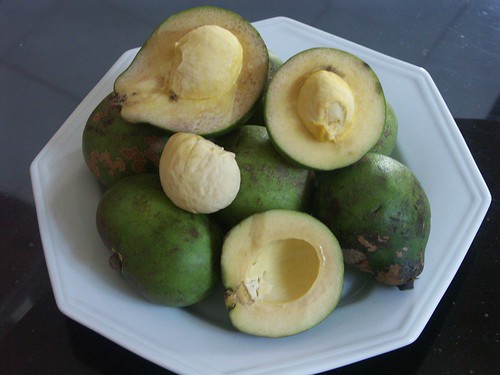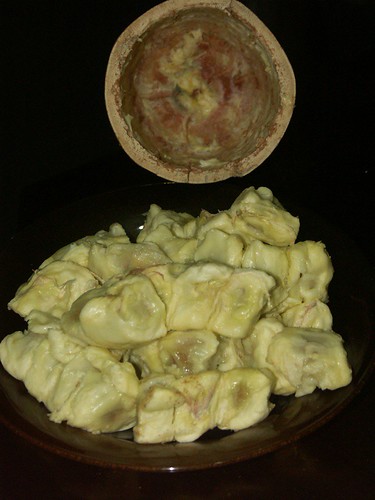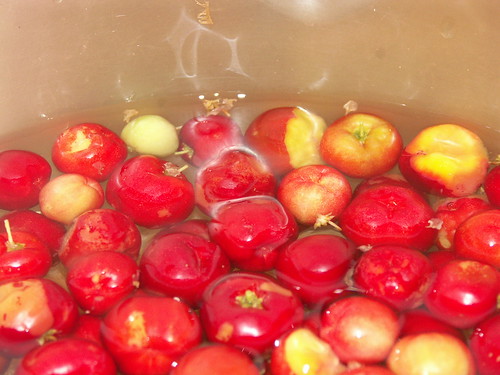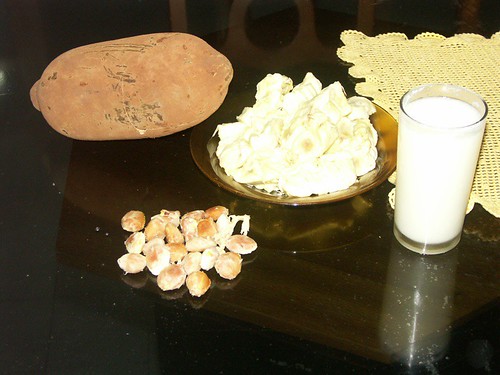The acerola is a fruit that is about the size and shape of a cherry. None of the ones I have eaten have been sweet. I have not eaten many, so I don't know if they are supposed to ripen more, or not.
They do have a rather pleasant bitter flavor, which, with a bit of sugar is very good. Typically these are served in the form of juice.

This very odd fruit (called Jackfruit in English) is about the size of a basketball, and is covered with short, spiny green things. They are not really sharp, as in cactus, but they are a little sharp. The edible part is around the seed, and has the consistency of garlic, or similar. Not much flavor here. In the lower center of the photo there is a seed with the meat on, and a seed without the meat.
The pitomba is also about the size of a cherry. However, the seed takes up such a large portion of the fruit area, that there is almost no fruit at all. Even so, there are many vendors on the streets who sell these, so they must be pretty popular. The outside of the fruit (the skin, or peel) is sort of like a leathery orange peel, but thinner, and not connected to the fruit like an orange peel is. The fruit itself gives kind of a dry feeling on the tongue, but is quite wet. I think it sort of recalls the flavor of lemon in a way, but not as strong by a long shot. This might be one you just have to try yourself, as I am having difficulty coming up with descriptors for it. I am open to suggestions in the comments (though, it would help if you have actually eaten this...).

Here is another fruit that has a difficult flavor to describe. It is also the only fruit of these that I have a strong distaste for (that said, I would rather eat this than panelada). The piqui [Portuguese] (good Scrabble word, by the way--if its in your dictionary) is eaten after being boiled. There is a thin coating of flour-like (in texture) meat on the seed, and this is what is cooked and eaten. The smell is very distinct and pungent, and reminds me of--well, it just reminds me of the first time I ate the fruit. One must scrape the meat off the seed with their teeth, and its kind of grainy and a bit flavorless to me, but my wife likes it, as do others around the house. If you get the opportunity to try it, do. I don't want to discourage anyone from trying new things just because I don't like them.

This is a fruit called bacuri. It is evidently a very good fruit to make juice out of. I don't remember its flavor, as this photo was taken almost (maybe over) a year ago.

This is a fruit called bacuri. It is evidently a very good fruit to make juice out of. I don't remember its flavor, as this photo was taken almost (maybe over) a year ago.

Here is probably the oddest fruit I have ever seen, touched, or eaten. Cupuaçu (coo-poo-a-su). It grows in a nut-like enclosure about a foot, to 16 inches long, by about 6 inches wide--on trees, I am told. This first picture shows the removed fruit of one enclosure, as well as the inside of half of one of the nut-like enclosure (I was going to use nut-case, but did not like the connotations that went along with it.).
Update: This post has been revised and added to at my new blog, it can now be found under the title "The Fruits of Brazil."



Karl,
ReplyDeleteThanks for your description of those fruits. It is very educative to see things we are used to from the perspective of someone who does not see it as we do.
I found the following recently in a very strange way, which I cannot explain, but it adds so much value that it is worth adding. Thank you Sarah!
ReplyDeleteSarah
I decided to ask my friend Google more about these interesting fruits, and here is what Google told me (sorry for such a long comment!):
Acerola: A dark red, cherry-like fruit which grows in the Caribbean, northern South America, central America and Mexico. It can now be found also in southern Texas and California. It has a high vitamin C content and much of the vitamin C supplements labeled ‘natural’ are made from acerola. They have a sweet, raspberry-like flavor. Acerola can be eaten fresh, but are mainly used in preserves and pies.
Also known as Barbados Cherry and West Indian Cherry.
Jaca: Jackfruit (Artocarpus heterophyllus) also known as jakfruit, jaca, and nangka, is a tropical tree originally from western India. It is a member of the mulberry family, and a relative of the breadfruit.
The jackfruit is a melon shaped starchy vegetable that can reach a length of 3 feet, and weigh up to 100 pounds, making it the largest tree-borne fruit in the world. The fruits grow both from the tree trunk and from branches in the tree. The fruit grows about ten meters above the ground and every year people are killed by jackfruit falling on their heads. The fruit has a rough, spiny skin and the uncut ripe fruit has a strong unpleasant smell, resembling rotting onions - but the cut fruit has a strong aroma similar to papaya or pineapple.
The interior consists of large bulbs of pulp enclosing a seed up to 1 inch long, with from 100 to 500 seeds per fruit. The flavor is similar to pineapple & banana but less juicy. The green unripe flesh is cooked as a vegetable and used in curries and salads. When ripe and sweet, it is eaten as a fruit. The large seeds are roasted and have a flavor and texture similar to chestnuts. The seeds can also be boiled and eaten. Watch out for the sap–it can stain your clothes.
“To stick your foot in a jaca” is to get horribly drunk.
Jackfruit is rarely available fresh in the U.S., but can be found canned in Asian grocery stores.
Pitomba: The pitomba produces bright orange-yellow fruit with soft, melting, juicy flesh with a highly aromatic slightly acid flavour. The fruit have an apricot flavor and color. They are good eaten fresh or made into jelly and preserves.
(Most of the pictures I saw online of the pitomba, however, looked different than the picture you posted – they had more flesh, and were bright orange in color. So…this description may not apply!)
Piqui: A wild savory fruit which grows on the spiny piqui tree and has a yellow pulp.
Abacate: I did find this recipe online, which validates your guess that these are avocados!
Creme de abacate
(Avocado Cream)
Most Americans are surprised when they see avocado cream in the dessert menu in Brazil. In the USA, avocados are usually used in savory dishes like salads or sandwiches or as guacamole. In Brazil, they become delicious ice-creams and creamy desserts like this one. The fruit are also amazingly huge down there, so when I say large in the recipe I mean LARGE.
1 large avocado, peeled and pitted
2 Tbsp fresh lime juice (I like mine on the tart side)
2-3 Tbsp sugar
Place all ingredients in a blender and puree. Serve in a stemmed glass; it looks beautiful and will impress your guests no end. You can also use a fork and mash the fruit with the lime juice, then add sugar to taste and serve it in little bowls. Decorate with a little sprig of mint.
Cupuaçu: A small to medium tree in the Rainforest canopy which belongs to the Cocoa family and can reach up to 20 meters in height. Cupuacu fruit has been a primary food source in the Rainforest for both indigenous peoples and animals alike. The Cupuacu fruit is known for its creamy, exotic-tasting pulp. The pulp is used throughout Brazil and Peru to make fresh juice, ice cream, jam and tarts. The fruit ripens in the rainy months from January to April and is considered a culinary delicacy in South American cities where demand outstrips supply. The “beans” are utilized by the indigenous Tikuna people for abdominal pains.
Because of the close relationship to the Cocoa-tree, in addition to pulp production the seeds can be used for manufacturing chocolate-like foodstuffs. There are initiatives throughout Brazil to develop Cupuaçu Chocolate, in Brazil also known as “Cupulate”. In Japan this product is already being produced and commercialized.
It contains unique antioxidant phytonutrients called polyphenols. You may be familiar with polyphenols from other common medicinal plants, notably green tea and grape seeds.
Cupuaçu also contains at least nine other known antioxidants including Vitamin C and Vitamin A, making it a well-rounded antioxidant “cocktail.”
Top 5 reasons to make Cupuaçu a regular part of your diet:
*Increased ability to fight disease and cancer
*More youthful and healthier-looking skin and hair
*Lower cholesterol levels
*Increased libido and stamina
*A cell-protective antioxidant cocktail
Oct 13, 10:53 AM
Hello,
ReplyDeleteSorry for my poor english, I'm french from TAHITI.
I collected a lot of tropical fruits trees and I see some fruits that I looking for a very long time on your blog .
It's very very difficut for me to find them
Please can you help me to have fresh seeds or entire fruits ?
BACURI and PITOMBA
I can pay you if you want.
My email is : fruitsmoe@yahoo.fr
What is yours ?
Please answer me !
yours faithfully,
Moe
Piqui - be forewarned not to bite into the seed, which contains tiny needle-like spines that will get lodged throughout your mouth and tongue (causing havoc to your mucous membrane), each requiring painstaking removal with a tweezer
ReplyDeleteAccording to Brazilians who have unknowingly suffered from biting into dishes made with piqui (variants pequi, amendoa-de-espinhas, meaning almond with spines)
Brazilians know that it is hazardous to bite into the piqui fruit.
ReplyDeleteFrom a 'gringo' living in Brasil